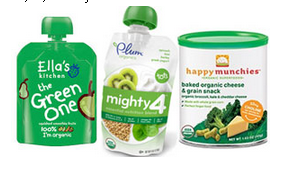 U.S. birth rates and a sluggish economic recovery have rattled the baby food market in recent years, spurring a 9% sales decline from 2008 to 2010, according to Chicago-based market research firm Mintel International.
U.S. birth rates and a sluggish economic recovery have rattled the baby food market in recent years, spurring a 9% sales decline from 2008 to 2010, according to Chicago-based market research firm Mintel International.But new innovation in formulation and packaging, as well as a growing interest in organic products, may be the formula to fuel category growth. At least that’s the hope of several companies that added baby food brands to their portfolios this year.
Even Pierre-Andre Terisse, chief financial officer of Danone S.A., admitted purchasing the Happy Family organic baby food brand in May was “a pretty interesting move” for the company.
“For the past few years now, (the baby food category has) been very dynamic and growing mid-single digits,” Mr. Terisse said during a July 30 earnings call with financial analysts. “That’s on the back of a few companies that have been launching really modernized products with different products or packaging forms, with different ingredients, with organic version.”
On-trend healthy ingredients in new products are expected to draw consumers who might not otherwise use store-bought baby food. Kale, quinoa and Greek yogurt are popping up in pouch products, such as the Mighty 4 line that debuted in July from Plum Organics, which the Campbell Soup Co. acquired in June.
“Plum Organics gives us a growth platform in the premium organic segment of the $2 billion U.S. baby food category, a segment that grew at an average annual rate of 43% from 2010 to 2012,” said Denise Morrison, president and chief executive officer of Campbell, during an Aug. 29 earnings call with analysts. “With the No. 2 share in the organic baby food category, Plum Organics also gives us access to millennial parents for whom organic nutrition is a high priority, and it’s a strategic fit with our $1 billion kid’s platform.”
The Hain Celestial Group also saw promise in premium in May when it bought the Ella’s Kitchen brand of organic baby food, which joined the Earth’s Best brand of organic baby food and snacks to create a global infant, toddler and kids division.
“…both Earth’s Best and Ella’s (are) up double-digit numbers; the baby rate is down,” said Irwin Simon, president and chief executive officer of Hain Celestial during an Oct. 8 presentation for analysts at the company’s Lake Success, N.Y., headquarters. “Consumers’ first entry into organics is baby food, whether it’s Gerber, whether it’s Beech-Nut, etc. That’s where the consumer is moving over from. And that’s where we’re taking consumption away.”
Indeed, 75% of parents with children younger than 3 years old think natural ingredients or no additives or preservatives are essential attributes for baby food, and nearly half say organic is important, according to Mintel. Organic baby food products represented about a third to half of new category launches between 2007 and 2012, and interest in the segment is expected to keep growing, Mintel said. During the five-year period, 11 of the top 20 innovating brands were organic baby food companies, led by Earth’s Best, which grew its number of releases by 55% within the period.
Packaging, too, has played a role in category growth. Recloseable, flexible pouches have expanded usage to older children and even adults, contributing to a projected 22% growth in the market from 2012 to 2017, Mintel said.
While the baby formula segment dominates sales in the category, with more than 70% of market share, the growth rate of baby food and snacks skews higher. The baby formula segment increased 6% from 2010 to 2012, as baby food and snacks climbed 12% during the two-year period.







